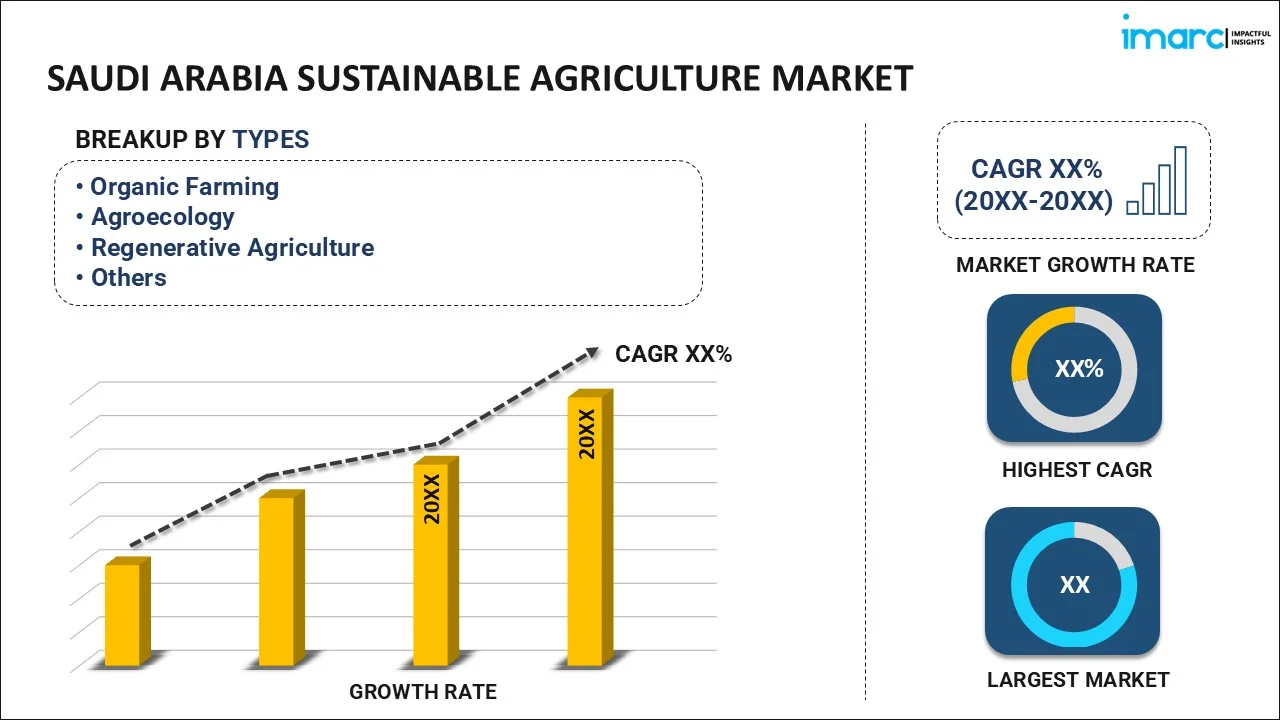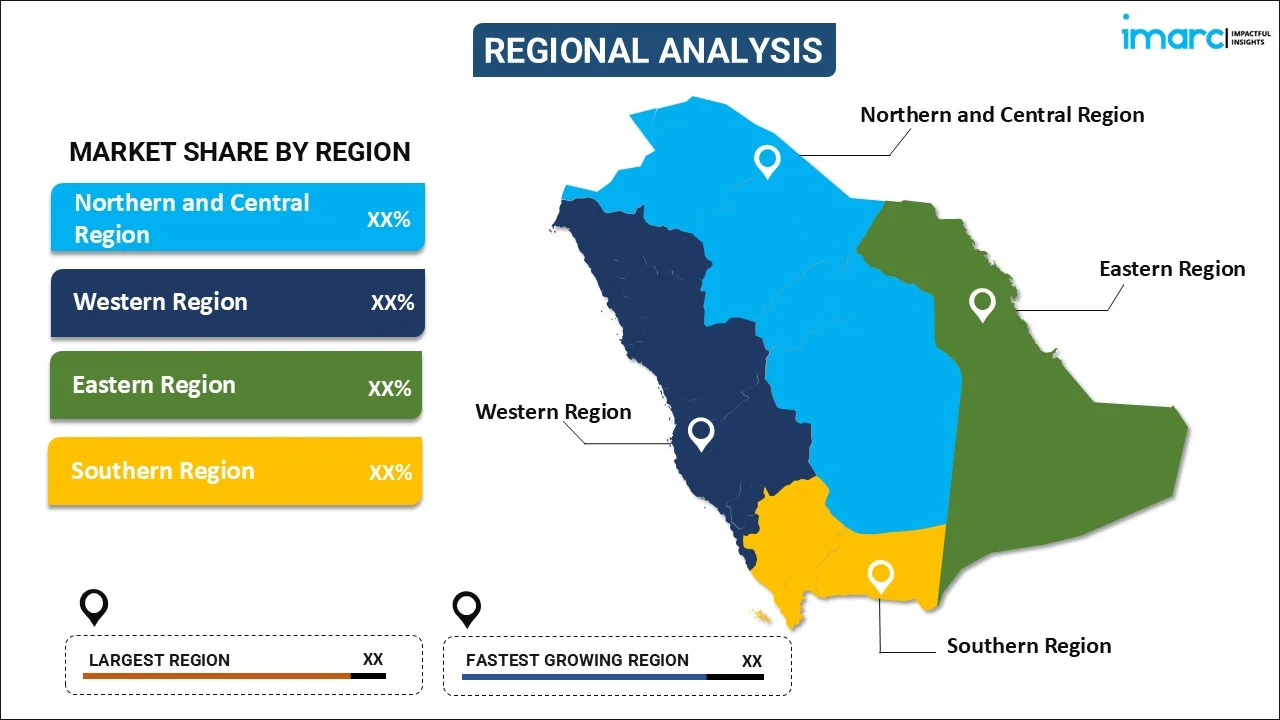
Saudi Arabia Sustainable Agriculture Market Size, Share, Trends and Forecast by Type, End Use Application, and Region, 2025-2033
Saudi Arabia Sustainable Agriculture Market Overview:
The Saudi Arabia sustainable agriculture market size reached USD 0.13 Billion in 2024. Looking forward, IMARC Group expects the market to reach USD 0.30 Billion by 2033, exhibiting a growth rate (CAGR) of 9.70% during 2025-2033. The Saudi Arabia sustainable agriculture market share is driven by government commitment to food security, the adoption of advanced technologies, and increasing awareness about environmental sustainability.
|
Report Attribute
|
Key Statistics
|
|---|---|
|
Base Year
|
2024 |
|
Forecast Years
|
2025-2033
|
|
Historical Years
|
2019-2024
|
| Market Size in 2024 | USD 0.13 Billion |
| Market Forecast in 2033 | USD 0.30 Billion |
| Market Growth Rate (2025-2033) | 9.70% |
Saudi Arabia Sustainable Agriculture Market Trends:
Government Commitment to Food Security and Sustainability
The Government of Saudi Arabia is placing topmost priority on food security as an important national agenda due to its relevance for ensuring economic stability and sustainability of the country, especially during any world supply chain breakage. As a means to respond to scarcity of water supplies and small pieces of arable land, Saudi Arabia is evolving towards adopting eco-friendly agriculture farming techniques to minimize usage of available resources. This change is driven by fresh policy aimed at building local participation in food production for the purpose of minimizing import reliance and achieving self-sufficiency. Environment-friendly practices such as hydroponics and vertical farm are being practiced as part of this strategic shift. For example, Saudi Arabia's Ministry of Environment, Water, and Agriculture sanctioned an SR4 billion 2023-2025 greenhouse expansion plan to expand agricultural production by 430,000 tons, raising the overall capacity to more than 1 million tons every year. Today's capacity is 613,590 tons with an anticipated growth of approximately 70%. The current move goes in accordance with Vision 2030 to support food security, local content contribution, and employment opportunities. Government support and grants for research and development (R&D) of sustainable agriculture further drives the Saudi Arabia sustainable agriculture market outlook by promoting the implementation of new technologies and assisting farmers in adopting more sustainable approaches.
Adoption of Advanced Agricultural Technologies
Technological innovation plays a central role in strengthening the Saudi Arabia sustainable agriculture market growth. For instance, in November 2024, Nabt, a Saudi agritech startup, secured SAR 5.63 million ($1.5 million) in seed funding, led by technology-focused Merak Capital and supported by angel investors, to revolutionize the Kingdom’s fresh produce ecosystem. With this investment, Nabt aims to deploy innovative solutions that address key challenges in the region, such as water scarcity, high energy consumption, and limited arable land. The startup plans to introduce precision irrigation systems, vertical farming techniques, and AI-powered crop monitoring, which together will optimize water and nutrient use, boost crop yields, and reduce waste. The integration of these technologies not only enhances productivity but also supports sustainability by minimizing waste and reducing the environmental footprint of agricultural practices. By leveraging advanced technologies, Nabt contributes to the long-term resilience and efficiency of Saudi agriculture.
Saudi Arabia Sustainable Agriculture Market Segmentation:
IMARC Group provides an analysis of the key trends in each segment of the market, along with forecasts at the regional level for 2025-2033. Our report has categorized the market based on type and end use application.
Type Insights:

- Organic Farming
- Agroecology
- Regenerative Agriculture
- Conservation Agriculture
- Precision Agriculture (Farming Tools)
The report has provided a detailed breakup and analysis of the market based on the tyoe. This includes organic farming, agroecology, regenerative agriculture, conservation agriculture, and precision agriculture (farming tools).
End Use Application Insights:
- Food Production
- Bioenergy
- Environmental Services
- Water Management
A detailed breakup and analysis of the market based on the end use application have also been provided in the report. This includes food production, bioenergy, environmental services, and water management.
Regional Insights:

- Northern and Central Region
- Western Region
- Eastern Region
- Southern Region
The report has also provided a comprehensive analysis of all the major regional markets, which include Northern and Central Region, Western Region, Eastern Region, and Southern Region.
Competitive Landscape:
The market research report has also provided a comprehensive analysis of the competitive landscape. Competitive analysis such as market structure, key player positioning, top winning strategies, competitive dashboard, and company evaluation quadrant has been covered in the report. Also, detailed profiles of all major companies have been provided.
Saudi Arabia Sustainable Agriculture Market News:
- In October 2024, Iyris and Red Sea Global launched the National Food Production (NFP) Initiative in Saudi Arabia, collaborating with public and private sector partners to improve sustainable agriculture and food security, aligning with Vision 2030. The initiative developed a 0.75-hectare farming facility in Bada, employing Saudi-based agri-tech to grow crops like tomatoes and herbs. This facility extended the typical growing season, supporting local farmers in harsh climates and reducing reliance on imports, which currently reach up to 85% in some cases. The project incorporates eco-friendly practices, such as SABIC's TRUCIRCLE materials, to minimize environmental impact. The initial harvest proved the model’s scalability, offering a blueprint for climate-resilient, sustainable farming solutions.
Saudi Arabia Sustainable Agriculture Market Report Coverage:
| Report Features | Details |
|---|---|
| Base Year of the Analysis | 2024 |
| Historical Period | 2019-2024 |
| Forecast Period | 2025-2033 |
| Units | Billion USD |
| Scope of the Report |
Exploration of Historical Trends and Market Outlook, Industry Catalysts and Challenges, Segment-Wise Historical and Future Market Assessment:
|
| Types Covered | Organic Farming, Agroecology, Regenerative Agriculture, Conservation Agriculture, Precision Agriculture (Farming Tools) |
| End Use Applications Covered | Food Production, Bioenergy, Environmental Services, Water Management |
| Regions Covered | Northern and Central Region, Western Region, Eastern Region, Southern Region |
| Customization Scope | 10% Free Customization |
| Post-Sale Analyst Support | 10-12 Weeks |
| Delivery Format | PDF and Excel through Email (We can also provide the editable version of the report in PPT/Word format on special request) |
Key Questions Answered in This Report:
- How has the Saudi Arabia sustainable agriculture market performed so far and how will it perform in the coming years?
- What is the breakup of the Saudi Arabia sustainable agriculture market on the basis of type?
- What is the breakup of the Saudi Arabia sustainable agriculture market on the basis of end use application?
- What are the various stages in the value chain of the Saudi Arabia sustainable agriculture market?
- What are the key driving factors and challenges in the Saudi Arabia sustainable agriculture market?
- What is the structure of the Saudi Arabia sustainable agriculture market and who are the key players?
- What is the degree of competition in the Saudi Arabia sustainable agriculture market?
Key Benefits for Stakeholders:
- IMARC’s industry report offers a comprehensive quantitative analysis of various market segments, historical and current market trends, market forecasts, and dynamics of the Saudi Arabia sustainable agriculture market from 2019-2033.
- The research report provides the latest information on the market drivers, challenges, and opportunities in the Saudi Arabia sustainable agriculture market.
- Porter's five forces analysis assist stakeholders in assessing the impact of new entrants, competitive rivalry, supplier power, buyer power, and the threat of substitution. It helps stakeholders to analyze the level of competition within the Saudi Arabia sustainable agriculture industry and its attractiveness.
- Competitive landscape allows stakeholders to understand their competitive environment and provides an insight into the current positions of key players in the market.
Need more help?
- Speak to our experienced analysts for insights on the current market scenarios.
- Include additional segments and countries to customize the report as per your requirement.
- Gain an unparalleled competitive advantage in your domain by understanding how to utilize the report and positively impacting your operations and revenue.
- For further assistance, please connect with our analysts.
 Inquire Before Buying
Inquire Before Buying
 Speak to an Analyst
Speak to an Analyst
 Request Brochure
Request Brochure
 Request Customization
Request Customization




.webp)




.webp)












